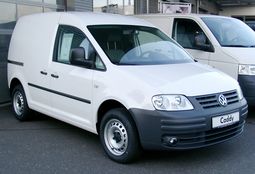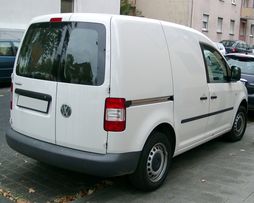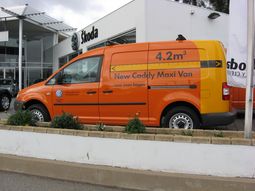The History Of Volkswagen Caddy

The name Volkswagen Caddy has been used by the Volkswagen Group to describe four different Caddy models:
- Typ 14 was derived from the Volkswagen Golf Mk1,
- Typ 9U was derived from the Škoda Felicia pick-up,
- Typ 9K was derived from the Volkswagen Polo Mk3 (VW Caddy) / SEAT Ibiza (SEAT Inca) platform,
- Typ 2K was derived from the Volkswagen Touran platform with Golf Mk5 front suspension.
Released in 1980, the first Volkswagen Caddy is a light pickup truck, and van based on the Volkswagen Group A1 platform, shared with the small family car Volkswagen Golf Mk1.
VW Typ is:
- 147 = LHD
- 148 = RHD
Caddy debuts internationally as a Rabbit
The Caddy came into fruition when VW was experimenting with Golf derivatives, a station wagon and a pickup.
Volkswagen of America was interested in the pickup, when VW released the Caddy it first was produced at the VW Westmoreland County plant in Pennsylvania from 1979 to 1982.
It was known in North America as the VW Rabbit Pickup with trim levels such as LX and Sportruck.
The Caddy competed with other mini-pickups such as the Ford Courier and Subaru Brat of that time.
Caddy debuts in Europe
The Caddy nameplate was never used in the USA (since the name is slang for Cadillac motor car division). Its first use was in Europe in 1982 when the Caddy was debuted on the European Market.
European Caddys were built in Volkswagen's plant TAS in Sarajevo, Bosnia and Herzegovina from 1982 till 1992.
As of 2006[update], they are still produced in South Africa. The stamping equipment was shipped from Westmoreland County, Pennsylvania, the home of Volkswagen's only U.S. manufacturing plant, now defunct.
Engine specs
The 1980-1984 Caddy pickup used the following engines:
- 1.0 petrol
- 1.3 petrol
- 1.5 petrol
- 1.5 diesel (1980)
- 1.6 petrol
- 1.7 petrol
- 1.6 diesel w/ turbo in Canada and abroad
- 1.8 petrol
The current (post 2003) South African-spec VW Pickup (Caddy name dropped to not conflict with Caddy 2K) is only available with a 1.6 carb-fed engine producing 60 kW.
However during its long production in South Africa it has been available with the following engines:
- 1.6 petrol 63 kW
- 1.6 petrol 60 kW
- 1.6 diesel 44 kW
- 1.8 petrol 70 kW
Gallery
Released in 1996 to compliment the Typ 9K Caddy range, the rebadged Škoda Felicia Utility was the entry level Commercial Vehicle for the VWCV range.
The Typ 9U Caddy was built in Škoda's Kvasiny, Czech Republic plant.
Engines
- 1.6L MPI Petrol with 55kW / 75hp
- 1.9L Diesel with 47kW / 64hp
Features of Typ 9U Caddy
- 530 kg payload rating
- 2.0m2 loading area
- twin airbags
- length 4.12m
- width of 1.64m
- turning circle of 11.2m
- 3 point seatbelts
- option of twin airbags
- option of ABS brakes
- option of air-conditioning standard in Petrol model.
Released in 1996, the Volkswagen Caddy Typ 9K was a light van designed by the VW's Spanish subsidiary SEAT, and derived from the SEAT Ibiza 6K / VW Polo 6N, on the Volkswagen Group A03 platform, Polo 6N sharing the same platform parts as the Ibiza 6K.
It was built in Spain, at the Martorell factory of SEAT. This version of the Caddy was built from 1997 to 2003 in Europe. Its twin, the SEAT Inca, was quickly phased out when the SEAT marque was re-aligned as the "sporty" branch of the Volkswagen Group.
It is still under production in Argentina for the Latin American market. It received a cosmetic facelift in 2005, similar to the post-1999 Volkswagen Polo Mk3.
Features
- length 4.2 m
- loading area 2.6m2
- loading volume of 2.9 m3
- payload 550 kg
- two rear wing doors standard
- partition separating loading from driving space
- instruments with adjustable lighting
- power steering
- rear window heater
- rear windshield wiper
- dust and pollen filter
- side impact protection
- safety steering column with collapsable steering wheel
- two head restraints
- three point seatbelts
- drivers airbag passenger optional
- ABS with Electronic Differential Lock (EDL)
- air-conditioner
Note: The Electronic Differential Lock (EDL) employed by Volkswagen is not - as the name suggests - a differential lock at all. Sensors monitor wheel speeds, and if one is rotating substantially faster than the other (i.e. slipping), the EDL system momentarily brakes it. This effectively transfers all the power to the other wheel.
1996-2003MY Engines
- 1.4L Petrol 44kW / 60hp
- 1.6L Petrol 55kW / 75hp
- 1.9L Diesel SDI 47kW / 64hp
- 1.9L Diesel TDI 66kW / 90hp
In late 2003 at the RAI Commercial Vehicle Show in Amsterdam, VW Commercial Vehicles debuted the Typ 2K Caddy panel van.
The Typ 2K shares 50% of its modules with the Volkswagen Golf Mk5 and Volkswagen Touran
The new model Caddy has a more aerodynamic design, the angle of the windshield and A-pillar (car) is more horizontal, this makes the dashboard big and the hood small.
The full Caddy line-up varies from a Panel Van, Window Panel Van, Kombi (spartan seven-seat version), Caddy Life (7-seat family version), and a Camping version called the Caddy Tramper or Caddy Life Camper.
Caddy Panel Van
The Caddy Panel grew in size over the Caddy Typ 9K, it measures in length 4405 mm, width 1802 mm, height 1833 mm, wheelbase 2682 mm, has a 750 kg payload, and a loading volume of 3.2 m3.
The current shape Typ 2K Caddy for sale now in Europe since 2004 is a leisure activity vehicle with Volkswagen Golf Mk5 front suspension.
It resembles the compact MPV Touran, and is assembled at the Poznań factory in Poland, and in Changchun, China for FAW Volkswagen.
Caddy Life
The Caddy Life, a seven seat passenger orientated People Mover, debuted at the 2004 Frankfurt Show. It comes with twin sliding doors and a 608 kg payload.
Caddy Life has a flexible seating system. The two rear bench seat rows can be taken out of the vehicle altogether to give the vehicle 2850 litres of cargo room; if that's not enough the Caddy Life has a 1500 kg towing capacity.
In 2005 a Special Edition Caddy Life Colour Concept with two distinctive colours Red Spice and Ravenna Blue was released with upholstery fabrics, floor mats and a variety of other elements on the dash panel in the same colour as the exterior body and a leather trimmed steering wheel, gear and handbrake lever.
Caddy Life Tramper (Camper)
Based on the Caddy Life the Tramper or Camper (Australia) package comes with two seats and a table, a fold out awning that is packaged within the rear tailgate, a bed that is made by folding down the seats measures 1.10 m x 2.0 m, also curtains are standard for privacy, options include a 7 litre cool box.
Caddy Maxi and Caddy Maxi Life
Debuting at the 2007 Frankfurt Motor Show Volkswagen Commercial Vehicles presented the Caddy Maxi Life the people mover version of the Maxi range. The Caddy Maxi range carried over all of the Caddy engine and debuted for the first time the 2.0L TDI engine producing 103 kW/ 140 hp.
The Caddy Maxi family is 470 mm longer version of the Caddy with 4.2 m3 loading space, this is due to extensions of the wheelbase which measures 3002 mm an extended, rear overhang now 151 mm, plus the growth between the sliding doors and the rear axle now at 319 mm and payload is up to 800 kg to 810 kg on commercial versions.
The Caddy Maxi Tramper the camping version if the Caddy Maxi debuted at the 2008 AMI Leipzig Motor Show along with the Caddy Maxi EcoFuel Study.
Caddy in Australia
Since its introduction in the Australian market in 2005, the Caddy range has taken the market lead for Small Van market.
Even with the more premium pricing over its competition buyers still pay more for the TDI and DSG transmission options.
In 2007 Caddy almost had 42% of the Small Van market share.
Awards
- Professional Van and Light Truck Magazine's Small Van of the Year 2007 (UK)
- Van Fleet World's Best Small Van 2007 (UK)
- Fleet News - 2008 Best Small Van Award
- Professional Van and Light Truck Magazine's Small Van of the Year 2008 (UK) - Caddy Maxi
- Delivery Magazine Award - 2008 Best Small Van Caddy Maxi
Engines
- 1.4 16V – 75PS (74hp/ 55kW) – 126N·m (93lb·ft) (petrol) (discontinued)
- 1.4 16V – 80PS (79hp/ 59kW) – 132N·m (97lb·ft) (petrol)
- 1.6 8V – 102PS (101hp/ 75kW) – 148N·m (109lb·ft) (petrol)
- 2.0 EcoFuel – 109PS (108hp/ 80kW) – 160N·m (118lb·ft) (CNG)
- 1.9 TDI – 75PS (74hp/ 55kW) – 210N·m (155lb·ft) (diesel)
- 1.9 TDI – 105PS (104hp/ 77kW) – 250N·m (184lb·ft) (diesel)
- 2.0 SDI – 69PS (68hp/ 51kW) – 140N·m (103lb·ft) (diesel) (only for panel van)
- 2.0 TDI – 140PS (138hp/ 103kW) – 320N·m (236lb·ft) (diesel)
Gallery
From Wikipedia, the free encyclopedia
More About Volkswagen Caddy












|